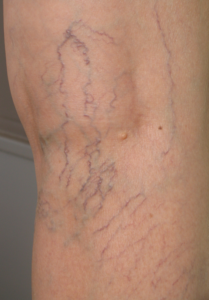How to Get Rid of Spider Veins Without Surgery
 Do you have spider veins? These unsightly little red, blue, and purple squiggles near the surface of the skin can make you feel uncomfortable and wreak havoc with your self-confidence. What, exactly, are spider veins? More importantly, what can you do to get rid of them?
Do you have spider veins? These unsightly little red, blue, and purple squiggles near the surface of the skin can make you feel uncomfortable and wreak havoc with your self-confidence. What, exactly, are spider veins? More importantly, what can you do to get rid of them?
Your veins are responsible for transporting blood to your heart and moving the blood. This is accomplished with valves in the veins that push the blood along. In some parts of the body, particularly the legs, these little valves are under a lot of pressure. If they’re weak or faulty, they may have trouble keeping the blood moving in the right direction. The muscles in your legs have a role to play, too. If your leg muscles aren’t moving enough, they won’t provide the extra energy that helps your blood circulate. When there’s not adequate circulation, blood can slip backward, pooling in the veins and damaging them. This can result in varicose vein or spider vein formation, as the vein walls bulge and begin to protrude through the surface of the skin.
There are certain factors that can increase your risk of spider veins. If you’re overweight, the additional pounds can put pressure on your veins. If you’re sedentary, the lack of motion can impede your circulation. As we age, our blood vessels weaken, but hormonal changes can weaken veins as well. That’s one reason that pregnancy often causes spider veins and varicose veins: the combination of extra weight and hormonal fluctuation creates the perfect situation for vein damage. If you drink or smoke, your veins can be affected, and certain skin conditions can impact your vein health. Genetics can also play a role, and if your parents have spider veins, you’re likely to develop them.
So, how are spider veins treated? You may have heard of spider vein treatment involving natural remedies like apple cider vinegar, herbal supplements, and essential oils, but do these things work? They may help boost circulation and alleviate some symptoms of spider veins, but they’re not FDA-approved to treat spider veins, and they won’t resolve the condition. What’s more, some natural remedies may interact with the medications you’re taking, leading to negative side effects. Massage by a licensed therapist may help relieve the pain and swelling of spider veins and promote healthy blood circulation.
Some people are nervous about seeking medical treatment for spider veins because they’re afraid they’ll have to go through a significant medical procedure like vein removal. Fortunately, that’s not actually the case. Today, medical treatments for spider veins are less invasive and more effective than they were in the past. Cosmetic sclerotherapy, for instance, works through the injection of a specialized solution into the vein to cause it to close off and collapse. Any blood that remains is rerouted to a healthier vein.
If you’re seeking the very best care for your vein and blood flow issues, trust the board-certified physicians at the Arizona Vein & Laser Institute. Using the most advanced technology, the vascular and cardiovascular surgeons at the Arizona Vein & Laser Institute provide care for all types of venous diseases. With over 40 years of experience, our team of experienced physicians can devise the right treatment plan to address your venous disease problems. For more information contact us through our website.
